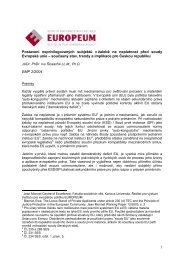eu constitutionalisation - EUROPEUM Institute for European Policy
eu constitutionalisation - EUROPEUM Institute for European Policy
eu constitutionalisation - EUROPEUM Institute for European Policy
Create successful ePaper yourself
Turn your PDF publications into a flip-book with our unique Google optimized e-Paper software.
Chapter 5: The <strong>European</strong> Constitution and the Re<strong>for</strong>m of External Competences<strong>for</strong>eign and security policy, without prejudice to the powers of the Union Minister<strong>for</strong> Foreign Affairs” (Art. I-22 para 2 CT). The <strong>European</strong> Commission, inturn, shall, with the exception of the common <strong>for</strong>eign and security policy, andother cases provided <strong>for</strong> in the Constitution, ensure the Union’s external representation(Art. I-26 para 1 CT). The President of the Commission has toensure that the Commission acts “consistently, efficiently and as a collegiatebody” which is a considerable challenge, given the vast field of externalrelations, and even more importantly, given that also the Union ForeignMinister <strong>for</strong>ms part of the Commission.¹⁶III.2. The <strong>European</strong> Council’s Role in the Field of External ActionThe implications of these institutional amendments will not be dealt within more detail in the framework of this contribution. There is one proposal,however, that merits further attention, as it would contribute to significantlyshifting the balance of powers between the EU institutions. It concerns theincrease of the <strong>European</strong> Council’s powers in the field of external action.Whilst already under the current regime, the <strong>European</strong> Council is entitledto define common strategies under Article 13 para 2 TEU, these strategiesare, however, limited to the field of CFSP. The CT, in turn, empowers the<strong>European</strong> Council to identify, on the basis of the (newly defined) principlesand objectives in the field of external relations (Art. III-292 CT), the strategicinterests and objectives of the Union. The <strong>European</strong> Council wouldthereby act by way of <strong>European</strong> decisions, thus legally binding acts which“shall relate to the CFSP and to other areas of the external action of the Union. Suchdecisions may concern the relations of the Union with a specific country or region, ormay be thematic in approach” (Art III-293 para 1 CT).The Union institutions, as well as the member states, would consequentlybe subordinated to such decisions of the <strong>European</strong> Council which set theguidelines <strong>for</strong> the entire area of external action. Such decisions, thoughnot even legislative acts in the definition of Art I-33 CT, would spearheadthe hierarchy of norms in the respective fields. There<strong>for</strong>e, even in thoseareas which now <strong>for</strong>m part of the first pillar and are subject to the so-called“Community method”, the foundations <strong>for</strong> legislative action are set byan “intergovernmental mechanism”, namely the <strong>European</strong> Council act-16) DUKE (2003), p.17.152Chapter 5: The <strong>European</strong> Constitution and the Re<strong>for</strong>m of External Competencesing unanimously.¹⁷ Admittedly, under the current regime, the <strong>European</strong>Council has not made extensive use of its power under the CFSP. It ratherlaid down the strategic guidelines applicable in the CFSP under Article 13.1TEU, thus acted by legally non-binding instruments. Yet, the resolutionsadopted by the <strong>European</strong> Council have frequently transcended a mereguideline-function and established detailed rules <strong>for</strong> legislative action inthe policy fields concerned. This applies even more to the Presidency conclusions,which are likewise legally non-binding, but which the <strong>European</strong>Council has efficiently used to boost the institutional and legal setting ofthe CFSP and the CSDP.¹⁸ It thus seems conceivable that the <strong>European</strong>Council would be tempted to refer to this power more frequently, giventhat it allows defining the path <strong>for</strong> the entire field of external relations. Asa counterweight to these extensive powers, Art. III-365 para 1 CT providesthat legal acts adopted by the <strong>European</strong> Council, which are intended toproduce legal effects vis-à-vis third parties are subject to judicial controlby the Court of Justice.¹⁹ This acknowledges the dominant function of the<strong>European</strong> Council, in its capacity of issuing legally binding decisions, andto some extent mitigates the deficit in the rule of law inherent in the CT. Yet,this review of legality by the Court is limited, as it only applies to acts by the<strong>European</strong> Council producing legal effects vis-à-vis third parties, and mayonly refer to those parts of an act which do not relate to the CFSP (Art. III-376 CT and Art. III-293 CT). ²⁰ This is un<strong>for</strong>tunate given that a comparablereview exists with respect to restrictive measures by the Council againstnatural or legal persons in the CFSP (Art. III-322 and III-376) and giventhe impressive powers that the CT bestows upon the <strong>European</strong> Council.The (albeit limited) control of the ECJ could have been regarded as anindispensable counterbalance. Moreover, it is questionable how the ECJ,in the case of a review of legal acts on the basis of Art. III-293 CT woulddraw a meaningful delimitation between the parts of a <strong>European</strong> decisionwhich relate to the CFSP and other fields of external relations.17) See GRILLER (2003), p.133-157: ‘If the respective powers of the <strong>European</strong> Council follow the decision makingprocedures of the CFSP, such a mechanism would entail, to the extent that the latter would remainintergovernmental in nature, the “intergovernmentalisation” of external policies in general, includingwhat currently comes under the first pillar. In essence, this would not enhance, but rather deterioratethe capacity of the Union to take efficient action in the field of external relations.’18) Compare BLANCK (2004), p.131ff referring in particular to the Presidency Conclusions of Helsinki (1999,Headline Goal), Feira (2000, Civil Headline Goal) and Nice (2000, Establishment of permanent bodies, suchas the PSC).19) CIG 52/1/03 REV1, p.5 and CIG 52/03ADD 1, Annex 7 (Article III-270(1)).20) CIG 79/04, Annex 24.153








